Properties
| Storage Buffer | PBS pH 7.4, 50% glycerol, 0.09% Sodium azide *Storage buffer may change when conjugated |
| Storage Temperature | -20ºC, Conjugated antibodies should be stored according to the product label |
| Shipping Temperature | Blue Ice or 4ºC |
| Purification | Protein G Purified |
| Clonality | Monoclonal |
| Clone Number | 1H11 |
| Isotype | IgG1 |
| Specificity | Conformation-specific antibody for membrane-bound HSP70. Binds to cell surface HSP70 without permeabilization of cell membrane in tumor cell lines. Does not bind to intracellular HSP70 at low concentrations. Cross-reacts with HSC70. Detects a ~70 kDa band in Western Blot. |
| Cite This Product | StressMarq Biosciences Cat# SMC-249, RRID: AB_2699628 |
| Certificate of Analysis | A 1:250 dilution of SMC-249 was sufficient for detection of cell surface HSP70 in HCT116 cells using Fluorescence-activated cell sorting, applied in flow cytometry, with FITC as the fluorescent probe. |
Biological Description
| Alternative Names | HSP70 1 Antibody, HSP70 2 Antibody, HSP70.1 Antibody, HSP72 Antibody, HSPA1 Antibody, HSPA1A Antibody, HSPA1B Antibody |
| Research Areas | Cancer, Cell Signaling, Chaperone Proteins, Heat Shock, Protein Trafficking, Tumor Biomarkers |
| Cellular Localization | Cell membrane |
| Accession Number | NP_005336.3 |
| Gene ID | 3303 |
| Swiss Prot | P0DMV8/P0DMV9 |
| Scientific Background | HSP70 is a highly conserved protein that is ubiquitously expressed. It can be found in chloroplasts, eukaryotic cytosol, endoplasmic reticulum, and mitochondria, but also embedded in the cell membrane and in the extracellular space (1,2,3,4). Even though HSP70 is one of the most studied heat shock proteins, the export mechanism and method of membrane insertion are not fully understood. The majority of the proteins in the heat shock family lack a consensus signal for secretion via the ER-Golgi pathway (5). Researchers have found that HSP70 may be released from cells via exosomes or secretory vesicles (6). Although HSP70 is ubiquitously expressed, there is not much information about its presence on cell surface. The finding that HSP70 is localized on the cell surface of cancer cells but not normal cells suggests a conformational change of HSP70 in the lower pH environment characteristic of cancer cells (7). The presence of cell membrane embedded HSP70 has been found to increase the stability of cancer cells, thereby protecting tumors from environmental stress (8, 9). Anti-HSP70 antibody, clone 1H11 (Catalog No. SMC-249) is unique from other commercially available antibodies in that it can bind to the extracellular region of the cell membrane embedded HSP70 protein, allowing researchers to differentiate between membrane bound and intracellular HSP70 across cancer cells types. |
| References |
1. Gribaldo, S. et al. (1999) J. Bacteriol. 181, 434-443. 2. Sharma, D. & Masison, D.C. (2009) Protein Pept. Lett. 16, 571-581. 3. Sharma, D. et al. (2009) PLoS. ONE.4, e6644. 4. Kampinga, H.H. & Craig, E.A. (2010) Nat. Rev. Mol. Cell Biol. 11, 579-592. 5. Nickel, W. & Seedorf, M. (2008) Annu. Rev. Cell Dev. Biol. 24, 287-308. 6. Multhoff, G. & Hightower, L.E. (1996) Cell Stress. Chaperones. 1, 167-176. 7. De Maio, A. (2011) Cell Stress. Chaperones. 16, 235-249. 8. Horvath, I. & Vigh, L. (2010) Nature. 463, 436-438. 9. Horvath, I., Multhoff, G., Sonnleitner, A., & Vigh, L. (2008) Biochim. Biophys. Acta 1778, 1653-1664. |
Product Images
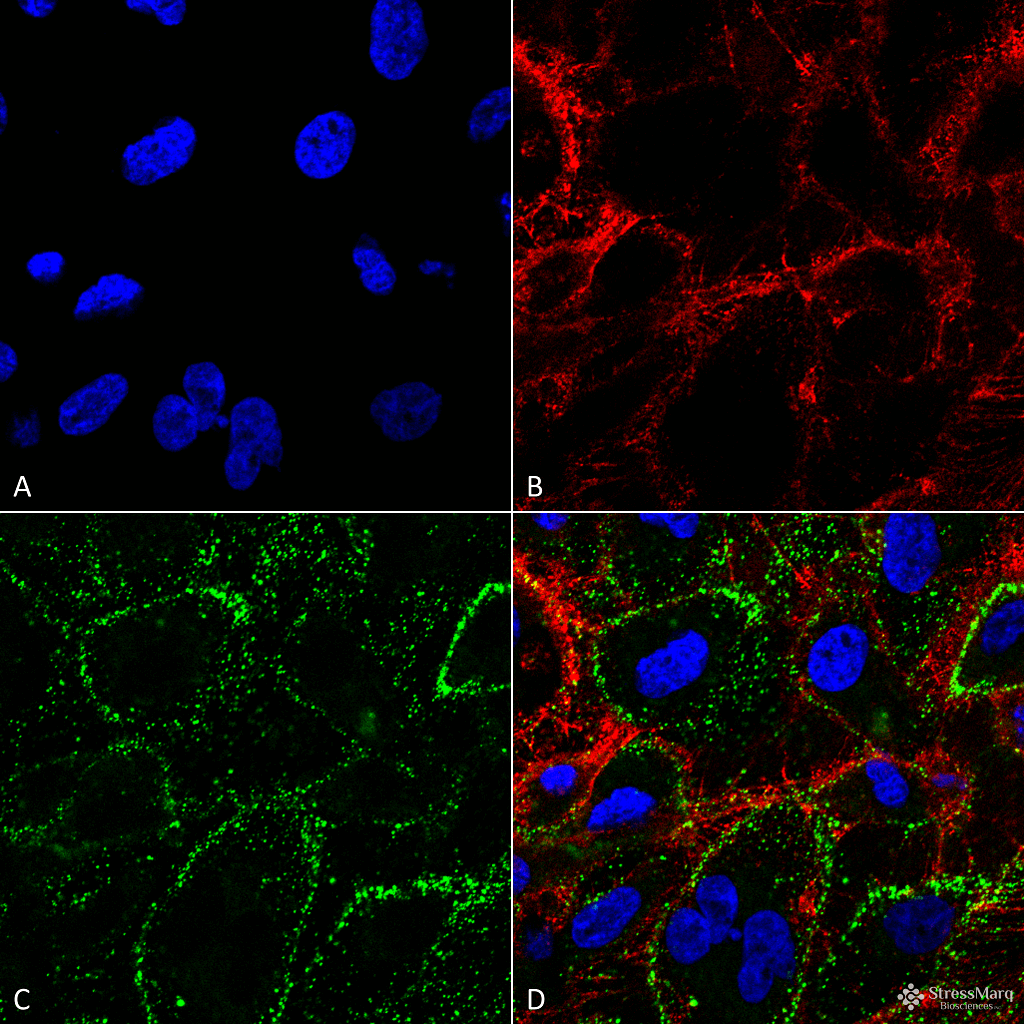
Immunocytochemistry/Immunofluorescence analysis using Mouse Anti-HSP70 Monoclonal Antibody, Clone 1H11 (SMC-249). Tissue: HCT116 cells. Species: Human. Fixation: 4% Formaldehyde. Primary Antibody: Mouse Anti-HSP70 Monoclonal Antibody (SMC-249) at 1:100. Counterstain: Wheat germ agglutinin Texas red membrane marker; DAPI (blue) nuclear stain. Localization: Cell surface, cell membrane. (A) DAPI nuclear stain. (B) Wheat germ agglutinin Texas red. (C) HSP70 Antibody. (D) Composite. Courtesy of: Lawrence Hightower, Charles Giardina, and Didem Ozcan from University of Connecticut.
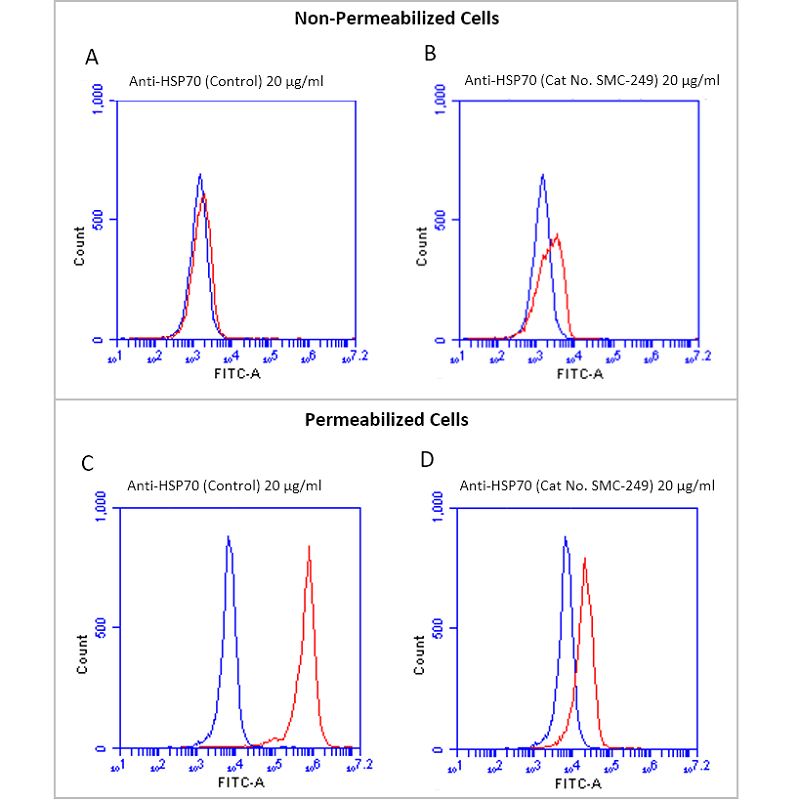
Fluorescence-activated cell sorting analysis using Mouse Anti-HSP70 Monoclonal Antibody, Clone 1H11 (SMC-249). Tissue: Jurkat E6.1 cells. Species: Human. Fixation: No fixation. Primary Antibody: Mouse Anti-HSP70 Monoclonal Antibody (SMC-249) at 20 µg/ml for 40 min at 4°C. Counterstain: Propidium Iodide nuclear stain at 2.5 µg/ml for 5 min at RT. Isotype Control: Anti-mouse FITC at 1:32 for 15 min at RT (blue line). Courtesy of: Dr. Elyse Ireland, Institute of Medicine, University of Chester.
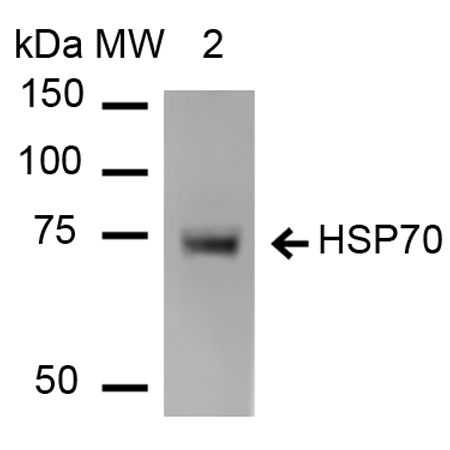
Western Blot analysis of Human Heat Shocked cervical cancer cell line (HeLa) lysate showing detection of HSP70 protein using Mouse Anti-HSP70 Monoclonal Antibody, Clone 1H11 (SMC-249). Lane 1: Molecular Weight ladder (MW). Lane 2: HeLa cell lysates. Load: 20 µg. Primary Antibody: Mouse Anti-HSP70 Monoclonal Antibody (SMC-249) at 1:1000.
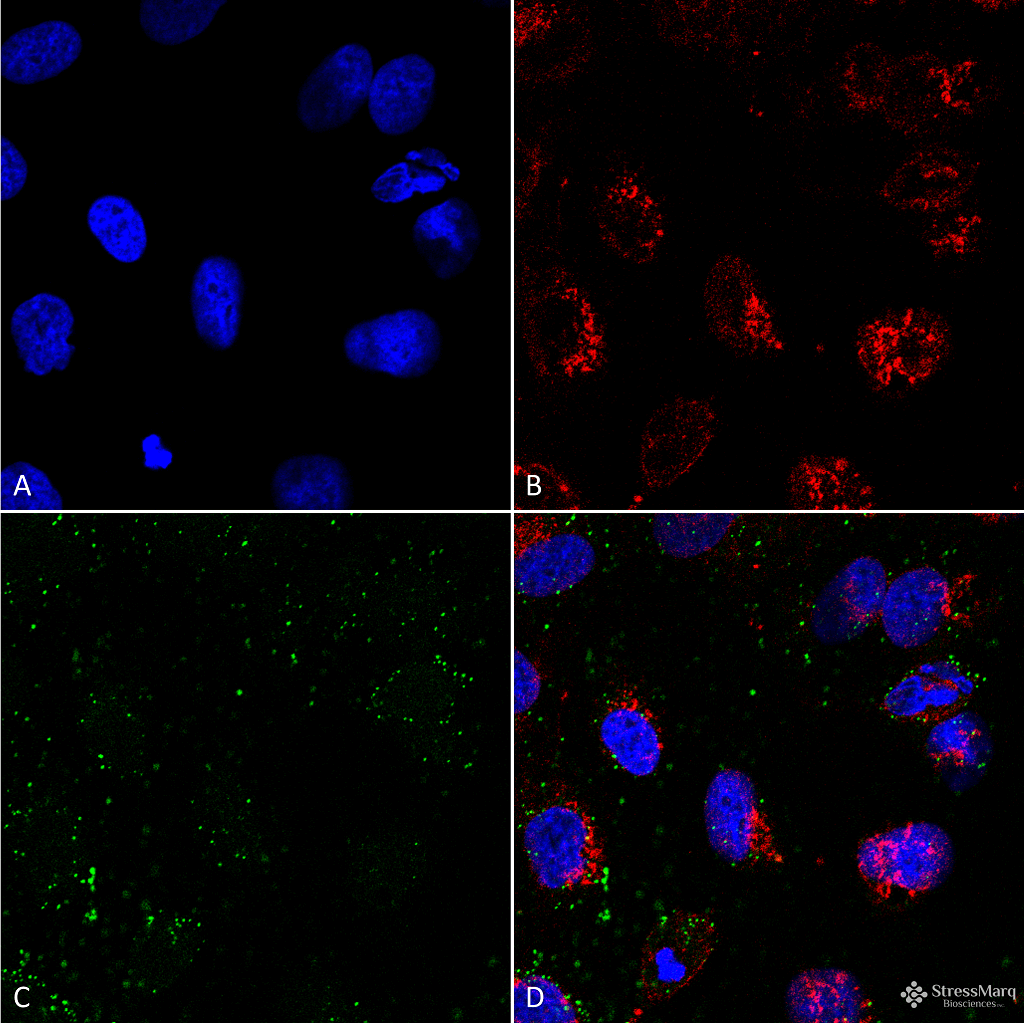
Immunocytochemistry/Immunofluorescence analysis using Mouse Anti-HSP70 Monoclonal Antibody, Clone 1H11 (SMC-249). Tissue: HCT116 cells. Species: Human. Fixation: 4% Formaldehyde. Primary Antibody: Mouse Anti-HSP70 Monoclonal Antibody (SMC-249) at 1:100. Counterstain: Wheat germ agglutinin Texas red membrane marker; DAPI (blue) nuclear stain. Localization: Cell surface, faint intracellular. (A) DAPI nuclear stain. (B) Wheat germ agglutinin Texas red. (C) HSP70 Antibody. (D) Composite. Courtesy of: Lawrence Hightower, Charles Giardina, and Didem Ozcan from University of Connecticut.
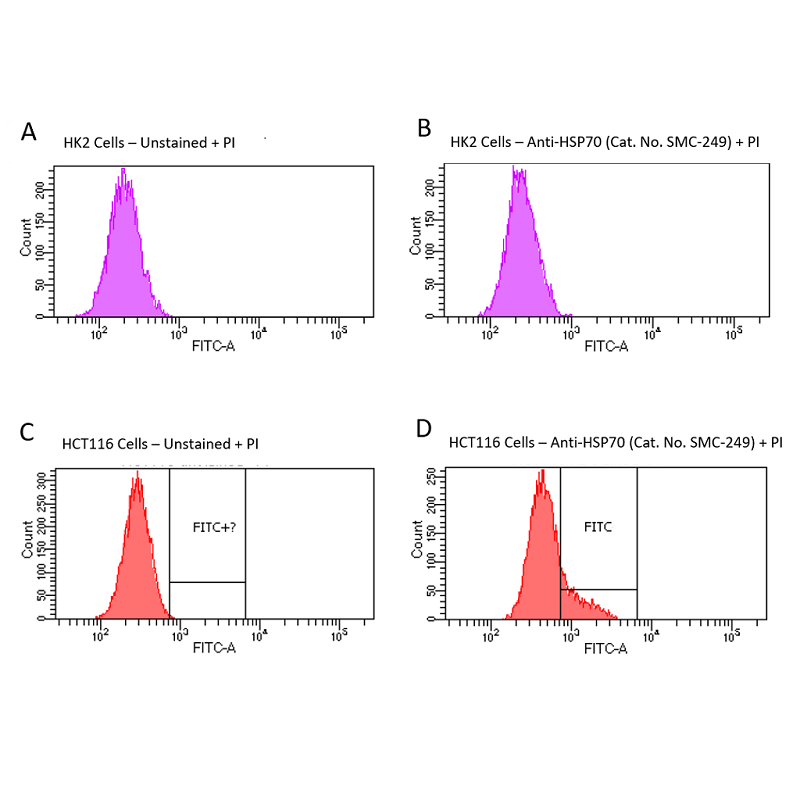
Fluorescence-activated cell sorting analysis using Mouse Anti-HSP70 Monoclonal Antibody, Clone 1H11 (SMC-249). Tissue: HCT116 and HK2 cells. Species: Human. Primary Antibody: Mouse Anti-HSP70 Monoclonal Antibody (SMC-249) at 1:100 for 90 min at 4°C. Counterstain: Propidium Iodide nuclear stain. (A) HK2 cells unstained. (B) HK2 cells and HSP70 Antibody. (C) HCT116 cells unstained. (D) HCT116 cells and HSP70 Antibody. Shows that HSP70 Antibody binds to the cell surface of tumor cells but not non-tumor cells. Courtesy of: Lawrence Hightower, Charles Giardina, and Didem Ozcan from University of Connecticut.
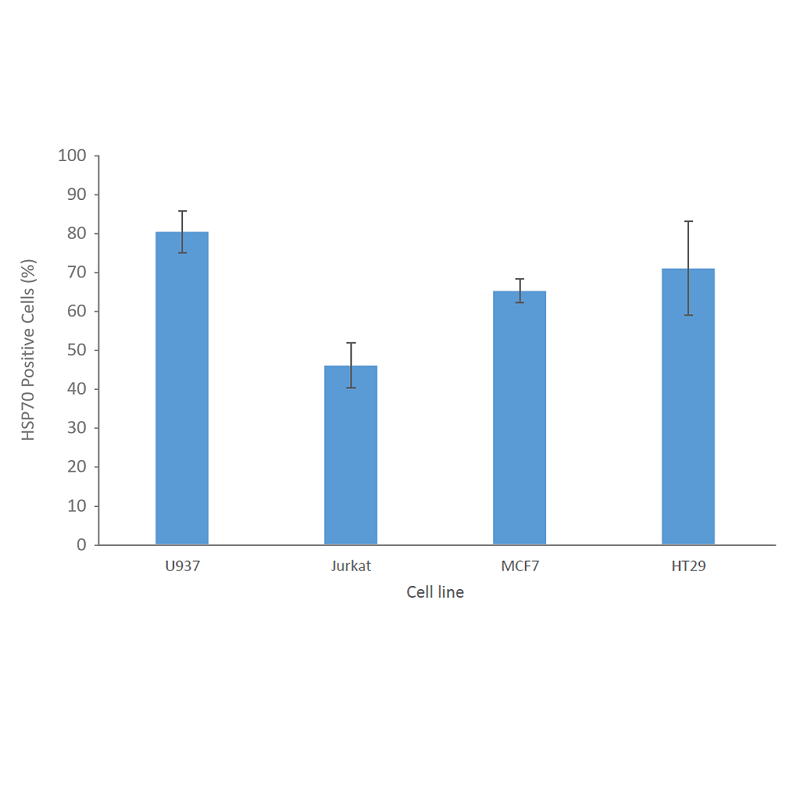
Fluorescence-activated cell sorting analysis using Mouse Anti-HSP70 Monoclonal Antibody, Clone 1H11 (SMC-249). Tissue: Jurkat E6.1, U937, MCF7 and HT29 cells. Species: Human. Fixation: No fixation. Primary Antibody: Mouse Anti-HSP70 Monoclonal Antibody (SMC-249) at 20 µg/ml for 40 min at 4°C. Counterstain: Propidium Iodide nuclear stain at 2.5 µg/ml for 5 min at 4°C. Shows that binding of HSP70 Antibody is not cell-line specific. Courtesy of: Dr. Elyse Ireland, Institute of Medicine, University of Chester.

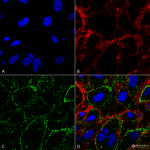
![Mouse Anti-HSP70 Antibody: FITC [1H11] used in Fluorescence-activated cell sorting (FACS) on Human Jurkat E6.1 cells (SMC-249)](https://www.stressmarq.com/wp-content/uploads/SMC-249-HSP70-Antibody-1H11-FACS-Human-Jurkat-E61-1-100x100.png)
![Mouse Anti-HSP70 Antibody [1H11] used in Western Blot (WB) on Human Heat Shocked cervical cancer cell line (HeLa) lysate (SMC-249)](https://www.stressmarq.com/wp-content/uploads/SMC-249-HSP70-Antibody-1H11-WB-Human-Heat-shocked-HeLa-cell-lysates-1-100x100.png)
![Mouse Anti-HSP70 Antibody: FITC [1H11] used in Immunocytochemistry/Immunofluorescence (ICC/IF) on Human HCT116 cells (SMC-249)](https://www.stressmarq.com/wp-content/uploads/SMC-249-HSP70-Antibody-1H11-ICC-IF-Human-HCT116-cells-2-100x100.png)
![Mouse Anti-HSP70 Antibody: FITC [1H11] used in Fluorescence-activated cell sorting (FACS) on Human HCT116 and HK2 cells (SMC-249)](https://www.stressmarq.com/wp-content/uploads/SMC-249-HSP70-Antibody-1H11-FACS-Human-HCT116-and-HK2-cells-1-100x100.png)
![Mouse Anti-HSP70 Antibody: FITC [1H11] used in Fluorescence-activated cell sorting (FACS) on Human Jurkat E6.1, U937, MCF7 and HT29 cells (SMC-249)](https://www.stressmarq.com/wp-content/uploads/SMC-249-HSP70-Antibody-1H11-FACS-Human-Jurkat-E61-U937-MCF7-and-HT29-cells-1-100x100.png)




















Samantha Chin :
High-quality antibody with ideal clone for tumor cell studies – great signal on the cytometer. See full review: https://www.biocompare.com/Product-Reviews/598227-High-quality-antibody-for-flow-cytometry/#disqus_thread
StressMarq Biosciences :
Based on validation through cited publications.